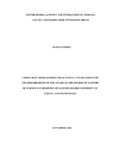ANTIMICROBIAL ACTIVITY AND INTERACTION OF TODDALIA ASIATICACOUMARINS WITH TWO KNOWN DRUGS
Abstract
Plant-derivedcompoundscouldexhibita directand/or anindirectantimicrobial activity asantimicrobialresistancemodifyingcompounds.Theireffectivenesscould further be increasedwhencombinedwithotherbioactivecompoundsorantibiotics (synergy).A systematicsearch forplant-derivedbioactive compounds,includingthosewhichcansynergistically actwithotherbioactive compoundsorantibiotics,asresistance modifyingagentsrepresentsa potential approachtoovercomingmicrobialresistance.Synergistic interactionof isolatedcoumarinsfromT.asiaticahadnotbeenreported prior to the current study, thus the basis for this work. It was also of interest to investigate possible synergistic effects of the isolated coumarins with known antimicrobials. Thisstudy evaluatedthe antimicrobialactivity ofthecrude,isolatedand combinedcoumarinsfromToddalia asiatica.Further to this, combination of the pure compounds and known antimicrobials were investigated for possible synergy.ThestemandrootbarkfromtheplantwerecollectedfromKakamegaforest inWesternKenyaandafterdrying separately, subjectedtosequentialsolventextractionwith organic solvents(n-Hexane,dichloromethaneandmethanol). Chromatographic separationof thecrudeextractsfollowed by characterization using spectroscopic techniques lead to the identification of six compounds namely:toddalolactone(1), coumurrenol(2), 5, 7-dimethoxy-6-(3'-methyl-,3'-hydroxyl–but–2-none) coumarine(3),toddaculin(5),andlupeol(6),[from the stembark]and5,7-dimethoxy–8-(3'-methyl-but-1',3'-diene)coumarine(4)[from the rootbark].Thisisthe firsttime compounds3and6are being reportedfromT.asiaticastembark.Compound 3(coumarin) had never been reportedprior to this work. Thecrudesandisolatedpurecompounds1,2, 3and4were evaluatedfortheirantimicrobial activity againstStaphylococcusaureus,Escherichiacoli,Penicilliumdigitatumand Rhizopusstoloniferusing bothdilutionanddiscdiffusionsusceptibilitymethods. Antimicrobial activity of combinedcompounds2and3was alsoinvestigated together with their combination with standard drugs gentamycin and fluconazole against the same microbes.Analysisof variance (ANOVA) wasused toanalyze the discdiffusionresults.The individual isolated compounds and all the crude extracts (apart from that of stem bark hexane)showed considerable activity against all the organisms tested.Combinations of compound 3and fluconazole displayed additive effect in inhibiting the growth of Penicillium digitatumwith lowerMICof125μg/mL compared to that of fluconazole alone at 250 μg /mL. Combination of compounds 2and 3also showed additive effect in inhibiting Rhizopus stolonifer lowering the MIC from 500μg/mL (for both molecules) to 250 μg /mL. Interaction in antibacterial activity between compounds 2and 3lowered the MIC in action againstStaphylococcus aureus to 250μg/mL compared to individual compounds with MIC of 500μg/mL while showing additive effect.Statisticaldataanalysisofthebioassaysusingthe Statistics Packagefor Social Scientists(SPSS) illustrated significantvariation ofbioactivity betweenpureandcombined compounds2and3 (p<0.05).TheSpectrumofactivity observedinthepresentstudy isindicative that drug combinationcouldbe a possiblemethodtoobtaineffective medicinesagainst microbial resistance.

